|

What's
new
Albas
Bourbons
Centifolias
Chinas
Climbers
Damasks
English Roses
Gallicas
Hyb. Bracteatas
Hyb. Musks
Hyb. Perpetuals
Hybrid Teas
Miniatures
Modern Shrubs
Moss Roses
Noisettes
Rugosas
Species
Teas
Site
Index
Email
|
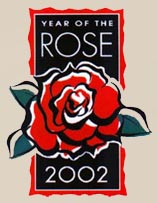 Welcome
to the November 2001 edition of my web site! The roses I write about
are the Old Garden Roses and select shrub and miniature roses of the
20th century.
For tips on rose culture, pruning, propagation and history, see "Other
resources on this site". To return to this page, click on the
"thorn icon" in the margin at left. Articles from the previous
months are archived and can be viewed by clicking on the listings in
the left margin. Oh, and please don't write to me for a catalog or pricelist.....this
is an information site only.....not a commercial nursery.
If you wish to buy roses, see my sponsor, The
Uncommon Rose. Thanks! Welcome
to the November 2001 edition of my web site! The roses I write about
are the Old Garden Roses and select shrub and miniature roses of the
20th century.
For tips on rose culture, pruning, propagation and history, see "Other
resources on this site". To return to this page, click on the
"thorn icon" in the margin at left. Articles from the previous
months are archived and can be viewed by clicking on the listings in
the left margin. Oh, and please don't write to me for a catalog or pricelist.....this
is an information site only.....not a commercial nursery.
If you wish to buy roses, see my sponsor, The
Uncommon Rose. Thanks!
"0-47-19",
Hybridizer's Touchstone.
By Paul Barden
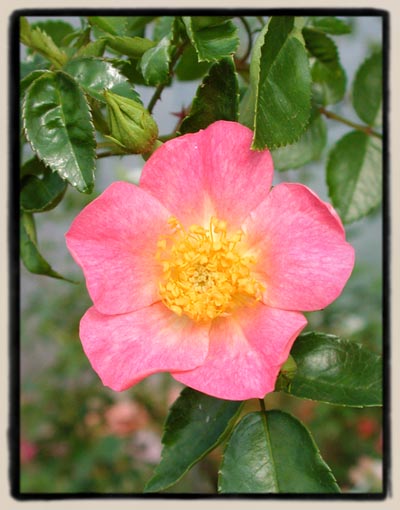 "About
1944 or so, a young man
crawled around on his hands and knees, pollinating blooms of a thorny
R. wichuraiana with pollen from a newly introduced FIoribunda called
'Floradora'. Little did he realize that fifty years later, his thorny
efforts would still be paying off for rose breeders, exhibitors and
"enjoyers" alike. "About
1944 or so, a young man
crawled around on his hands and knees, pollinating blooms of a thorny
R. wichuraiana with pollen from a newly introduced FIoribunda called
'Floradora'. Little did he realize that fifty years later, his thorny
efforts would still be paying off for rose breeders, exhibitors and
"enjoyers" alike.
At
left: "0-47-19".
"Mr.
Moore hoped to introduce the vigor, fertility and handsome, resistant,
evergreen foliage of the species (R wichuraiana) into his dreamed-of
miniatures. The rose that resulted was selected for breeding in 1947
and was given the unromantic name 0-47-19. From a genealogical
standpoint, in may well have been called Adam, for it was destined to
"go forth and populate the earth".
"0-47-19
probably wouldn't catch your attention, unless you like spring blooming,
R. wichuraiana climbers. It has smallish, semi-single, pale orange-pink
blooms. It did catch Mr. Moore's eye though, much to our good fortune."
*
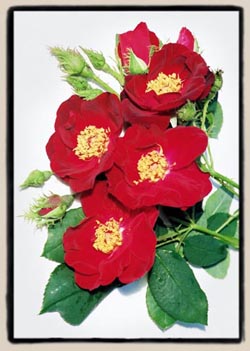 "0-47-19"
has been one of the single most important roses in the Moore breeding
program, having sired 68 roses, mostly named varieties, and almost all
miniatures. At first, it comes as an enormous surprise to realize that
so many of the Moore Miniatures have been created using what can only
be described as a typical R. wichuraiana rambler! However, as Ralph
Moore discovered early in his experiments in rose breeding, miniaturism
generally behaves as a dominant trait, and only one copy of the gene
need be present in a rose to be expressed. Ralph will also tell you
there seem to be more factors responsible for the expression of miniaturism
than simple Mendelian genetics dictates, and there is certainly some
quantitative expression as well. Within the selection of progeny from
"0-47-19", we have seen everything from standard 12 to 16 inch
miniatures of bush form, to climbing miniatures of 5 feet in height,
to the smallest microminiatures like 'Tiny
Flame', and even a few Ramblers with near-miniature blooms!
It has become evident that miniaturism can affect the plant size and
the blossom size independently at times. "0-47-19"
has been one of the single most important roses in the Moore breeding
program, having sired 68 roses, mostly named varieties, and almost all
miniatures. At first, it comes as an enormous surprise to realize that
so many of the Moore Miniatures have been created using what can only
be described as a typical R. wichuraiana rambler! However, as Ralph
Moore discovered early in his experiments in rose breeding, miniaturism
generally behaves as a dominant trait, and only one copy of the gene
need be present in a rose to be expressed. Ralph will also tell you
there seem to be more factors responsible for the expression of miniaturism
than simple Mendelian genetics dictates, and there is certainly some
quantitative expression as well. Within the selection of progeny from
"0-47-19", we have seen everything from standard 12 to 16 inch
miniatures of bush form, to climbing miniatures of 5 feet in height,
to the smallest microminiatures like 'Tiny
Flame', and even a few Ramblers with near-miniature blooms!
It has become evident that miniaturism can affect the plant size and
the blossom size independently at times.
It
is also of interest to note that since the mid-1980's, "0-47-19"
has not been used as much to create new miniatures, but has instead
been explored more in the creation of shrubs and climbers! There is
the as yet, unreleased climber called simply "C-10" which is
a deep ruby red Crested Climber descended from 'Crested
Moss' (R. centifolia cristata,
or 'Chapeau de Napoleon'). (Pictured
here above, right) It bears 3.5 to 4.5 inch, rich red blooms on a vigorous
climbing plant of about 10 to 12 feet in height. The buds show a very
good amount of cresting inherited from R. centifolia cristata, and the
plant has excellent, highly disease resistant foliage. It is a once-bloomer,
but makes a spectacular display over a long period. This is one of the
more remarkable roses to come out of "0-47-19" and is quite distinct
among its progeny. It shows that this is a versatile hybrid whose contributions
to rose breeding may have only just begun! (Please note: this
variety is still in testing and has NOT yet been released in commerce.
Please do not call Sequoia Nursery asking for it. It's introduction
will be announced when it comes available.)
"Its
first commercial product arrived in 1950 from a cross with 'Little
Buckaroo's pollen. It was called 'Lollipop' and was a bushy,
bright red, double miniature. Two years later, 'Lemon Drop' resulted
from pollen from his wonderful "Zee" and seed from
"0-47-19".
 "Over
a thirty-year period, sixty-one of Mr. Moore's introduced roses can
claim "0-47-19" as a direct parent. Many of these have, themselves,
enjoyed great longevity and productivity as parents. 'Papoose',
a single, white mini groundcover/climber bred from R. wichuraiana
X "Zee" and introduced in 1955, with 'Playboy's pollen,
produced 'Ralph's Creeper' in 1988. Many of the better known
Moore roses have come from this line, such as 'Little Buckaroo'
(1956), itself a tremendous parent; 'Yellow Bantam' and 'Eleanor'
(1960); 'Simplex' (1961), arguably the best single mini; 'New
Penny' (1962), used extensively by Mr. Moore, McGredy, Harkness
and dozens of other breeders; 'Red Wand' and 'Fresh Pink'
(1964), both great landscape plants; 'Tiny
Flame' and 'Candy Pink' (1969); 'Green
Ice' (1971); 'Red Cascade' (1976); 'Happy Thought'
(1978); 'Little Eskimo' (1981) and 'Red Moss Rambler'
(1990). Remarkable, isn't it? To think that a vigorous species, crossed
with a Floribunda, could create a parent that could produce everything
from climbing miniatures and climbing mosses, to the tiniest of micro-miniatures
is incredible. Mr. Moore is still exploring "0-47-19"s
genes. He has recently created a beautiful yellow climber from "0-47-19"
crossed with 'Sequoia Gold'. ("Bv158-91-10") There is still more
of this story to come." * "Over
a thirty-year period, sixty-one of Mr. Moore's introduced roses can
claim "0-47-19" as a direct parent. Many of these have, themselves,
enjoyed great longevity and productivity as parents. 'Papoose',
a single, white mini groundcover/climber bred from R. wichuraiana
X "Zee" and introduced in 1955, with 'Playboy's pollen,
produced 'Ralph's Creeper' in 1988. Many of the better known
Moore roses have come from this line, such as 'Little Buckaroo'
(1956), itself a tremendous parent; 'Yellow Bantam' and 'Eleanor'
(1960); 'Simplex' (1961), arguably the best single mini; 'New
Penny' (1962), used extensively by Mr. Moore, McGredy, Harkness
and dozens of other breeders; 'Red Wand' and 'Fresh Pink'
(1964), both great landscape plants; 'Tiny
Flame' and 'Candy Pink' (1969); 'Green
Ice' (1971); 'Red Cascade' (1976); 'Happy Thought'
(1978); 'Little Eskimo' (1981) and 'Red Moss Rambler'
(1990). Remarkable, isn't it? To think that a vigorous species, crossed
with a Floribunda, could create a parent that could produce everything
from climbing miniatures and climbing mosses, to the tiniest of micro-miniatures
is incredible. Mr. Moore is still exploring "0-47-19"s
genes. He has recently created a beautiful yellow climber from "0-47-19"
crossed with 'Sequoia Gold'. ("Bv158-91-10") There is still more
of this story to come." *
Mr.
Moore, speaking on his experience with "0-47-19":
"We
made crosses into R. wichuraiana, and the reason there was to
get something that rooted very easily, because wichuraiana will lay
on the ground and root at the joints like Bermuda grass. That is a rose
that is involved in a good share of the roses I have produced over the
years."
 "I
knew that the Rambler roses were based on wichuraiana, and they
rooted so readily. So I got a plant, and I didn't have sense enough
to put it on a trellis or anything like that. I let it spread out on
the ground. It was between some other climbing roses and when it started
to bloom, I had 'Floradora' and I just crawled around there and
pollenized a bunch of the flowers. It set seed and I planted these,
and I had 2 or 3 rows probably 30-40 feet long of the seedlings that
I transplanted into the field. Some were semi-double and there were
a few doubles and singles…. there were whites and pinks and so on. And
I selected one, and strangely it was the first one in the row, and that's
the one we know as "0-47-19". It's very profuse flowering, it's
very fragrant, flowers about 1.5 to 2 inches across, in clusters and
it has a kind of apricot bud and opens and gradually turns pink. But
it sets seed; every flower will set a seed hip. Eventually, right in
here where this greenhouse is, we had a row about 50 feet long and we
put it up (on a trellis) and worked it on a ladder. There are some old
pictures that show it, and we made thousands of crosses. We got mostly
one-time bloomers and climbers, but we got a few bushes. It was a key
variety because it has gone in so many directions. It can take pollen
from nearly any kind….it's still worth playing with. "I
knew that the Rambler roses were based on wichuraiana, and they
rooted so readily. So I got a plant, and I didn't have sense enough
to put it on a trellis or anything like that. I let it spread out on
the ground. It was between some other climbing roses and when it started
to bloom, I had 'Floradora' and I just crawled around there and
pollenized a bunch of the flowers. It set seed and I planted these,
and I had 2 or 3 rows probably 30-40 feet long of the seedlings that
I transplanted into the field. Some were semi-double and there were
a few doubles and singles…. there were whites and pinks and so on. And
I selected one, and strangely it was the first one in the row, and that's
the one we know as "0-47-19". It's very profuse flowering, it's
very fragrant, flowers about 1.5 to 2 inches across, in clusters and
it has a kind of apricot bud and opens and gradually turns pink. But
it sets seed; every flower will set a seed hip. Eventually, right in
here where this greenhouse is, we had a row about 50 feet long and we
put it up (on a trellis) and worked it on a ladder. There are some old
pictures that show it, and we made thousands of crosses. We got mostly
one-time bloomers and climbers, but we got a few bushes. It was a key
variety because it has gone in so many directions. It can take pollen
from nearly any kind….it's still worth playing with.
"It's
a typical old-fashioned Rambler, but if had come out in the early 1900's,
why, it would have found a good place, but it was too little, too late.
"About
25% of the seedlings are repeat blooming, dwarf plants. Of course, in
that you get some weak ones, well most of them are no good, let's put
it that way. The others would be (useful) if you wanted to grow them
out and bloom in the next generation for some crosses; you would get
some more bush types. There's also the possibility, depending what you
use, of picking up repeat blooming Ramblers, I think that's something
for the future. That was something I dreamed of over 60 years ago, but
we haven't done it.
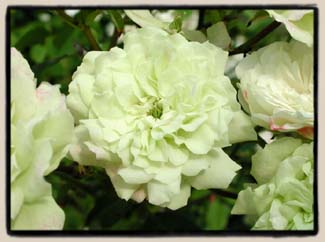 "We
have other roses that are repeat bloomers. Generally when you get a
repeat blooming climbing rose or a rambler, they're not as vigorous
as the one-time bloomers. On the other hand you get things like climbing
Hybrid Teas and such as that, and the tendency there is to give one
big shot of bloom in the spring and maybe some scattering along later
in the year….they're not really repeat bloomers. I don't have an objection
to some of some of these that bloom once in the spring when they do
such a marvelous display. They're worth waiting for. I tell people that
we grow things like Lilacs and flowering Quince, Crabapples and all
those things, and they only bloom once, and we wait for them and enjoy
them.** "We
have other roses that are repeat bloomers. Generally when you get a
repeat blooming climbing rose or a rambler, they're not as vigorous
as the one-time bloomers. On the other hand you get things like climbing
Hybrid Teas and such as that, and the tendency there is to give one
big shot of bloom in the spring and maybe some scattering along later
in the year….they're not really repeat bloomers. I don't have an objection
to some of some of these that bloom once in the spring when they do
such a marvelous display. They're worth waiting for. I tell people that
we grow things like Lilacs and flowering Quince, Crabapples and all
those things, and they only bloom once, and we wait for them and enjoy
them.**
When
asked why he became attracted to R. wichuraiana, Mr. Moore responded:
"The
species is quite mildew resistant actually. One of the chief things
I was interested in was the ease of propagation, because for years I
have been an own root enthusiast and I wanted something that would root
very readily, and when wichuraiana lays on the ground, it roots like
Bermuda grass at every joint. I think its important that the roses are
easy for the customer and gardener to grow, but its also important for
the nurseryman because the better plant he gets and the cheaper he can
produce it, the more popular it's likely to be. So a rose has to be
easy to grow from the time the nurseryman puts the first propagation
in, to the gardener in the garden with the least care.
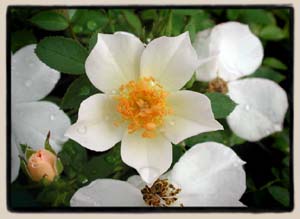 "Another
thing is that wichuraiana is very compatible with so many other
kinds of roses. In working with the miniatures, why, it gave the cluster
flowering habit which I liked. It's nice to have some for exhibition
that have one flower to a stem, but on the other hand, for a pot or
a garden, you want as many flowers as you can to get some color over
a long period of time. With clusters of flowers, they don't all open
at the same time, so you get a display of color for a long period of
time. "Another
thing is that wichuraiana is very compatible with so many other
kinds of roses. In working with the miniatures, why, it gave the cluster
flowering habit which I liked. It's nice to have some for exhibition
that have one flower to a stem, but on the other hand, for a pot or
a garden, you want as many flowers as you can to get some color over
a long period of time. With clusters of flowers, they don't all open
at the same time, so you get a display of color for a long period of
time.
"Another
thing about the wichuraiana is that it seems to pick up different
flower forms easily. Whether it's a rosette form, whether it's a single
or whether it's a pointed, classical Hybrid Tea bud, it just seems like
its easy to work with in many directions. There hasn't been a lot of
work done with wichuraiana, going back to the species, but I think it's
got a lot of possibilities." **
The
complete list (to date) of roses bred directly from "0-47-19"
Note that in every instance it serves as a seed parent only:
1950:
'Lollipop': 0-47-19 X 'Little Buckaroo', Miniature, medium red.
1954: 'Lemon Drop': 0-47-19 X "Zee", Miniature, light yellow.
1954: 'Snowflakes': 0-47-19 X "Zee", Miniature, white.
1956: 'Little Buckaroo': 0-47-19 X ('Oakington Ruby' X 'Floradora'),
Miniature, medium red.
1957: 'Dian': 0-47-19 X ('Oakington Ruby' X 'Floradora'), Miniature,
deep pink.
1957: 'Mary Haywood': 0-47-19 X 'Oakington Ruby', Miniature,
medium pink.
1957: 'Sparkie': 0-47-19 X 'Little Buckaroo' Miniature, medium
red.
1957: 'Spring Song': 0-47-19 X 'Thumbelina', Miniature, orange
pink.
1958: 'Perky': 0-47-19 X 'Oakington Ruby', Miniature, deep pink.
1958: 'Westmont': 0-47-19 X ('Oakington Ruby' X 'Floradora'),
Miniature, medium red.
1959: 'Bobolink': 0-47-19 X ('Oakington Ruby' X 'Floradora'),
Miniature, deep pink.
1959: 'Lollipop': 0-47-19 X 'Little Buckaroo', Miniature, medium
red.
1959: 'Pink Heather': 0-47-19 X ('Violette' X "Zee"), Miniature,
light pink.
1960: 'Eleanor': 0-47-19 X (seedling X "Zee"), Miniature, orange
pink.
1960: 'Yellow Bantam': 0-47-19 X 'Fairy Princess', Miniature,
light yellow.
1961: 'Baby Ophelia': 0-47-19 X 'Little Buckaroo', Miniature,
light pink.
1961: 'Lady Ann': 0-47-19 X 'Little Buckaroo', Miniature, medium
pink.
1961: 'Little Flirt': 0-47-19 X ('Golden Glow' X "Zee", Miniature,
red blend.
1961: 'Silver Tips': 0-47-19 X 'Lilac Time', Miniature, pink
blend.
1961: 'Simplex': 0-47-19 X Unnamed Seedling, Miniature, white.
1962: 'New Penny': 0-47-19 X Unnamed Seedling, Miniature, orange
red.
1962: 'Red Arrow': 0-47-19 X Unnamed Seedling, Miniature, medium
red.
1962: 'Tiny Jack': 0-47-19 X ('Oakington Ruby' X 'Floradora'),
Miniature, medium red.
1962: 'Tiny Jill': 0-47-19 X 'Little Buckaroo', Miniature, medium
pink.
1963: 'Frostfire': (0-47-19 X Seedling) X 'Little Buckaroo',
Miniature, medium red.
1963: 'June Time': (0-47-19 X 'Etoile Luisante') X ('Red Ripples'
X "Zee") Miniature, light pink.
1964: 'Fresh Pink': 0-47-19 X 'Little Buckaroo', Miniature, light
pink.
1964: 'Red Wand': (0-47-19 X 'Orange Triumph') X Unknown Miniature,
Climbing Miniature, deep pink.
1965: 'Lori Nan': 0-47-19 X (Seedling X "Zee"), Miniature, medium
pink.
1965: 'Trinket': 0-47-19 X 'Magic Wand', Miniature, medium pink.
1966: 'Pink Ribbon': 0-47-19 X 'Magic Wand', Miniature, light
pink.
1967: 'Little Mike': (0-47-19 X Seeding) X 'Little Buckaroo',
Miniature, dark red.
1968: 'Little Fireball': 0-47-19 X 'New Penny', Miniature, orange
red.
1969: 'Candy Pink': 0-47-19 X ('Oakington Ruby' X 'Floradora'),
Miniature, light pink.
1969: 'Magic Dragon': 0-47-19 X [(Soeur Therese X Wilhelm)**
X (Red Ripples X Little Buckaroo)], Climbing miniature, dark red. **
abbreviated in breeding records as "STW-1"
1969: 'Tiny Flame': 0-47-19 X 'New Penny', Miniature, orange-red.
1971: 'Green Ice': 0-47-19 X 'Jet Trail', Miniature, white blend.
(Recently inducted into the Miniature Roses Hall of Fame, 2001)
1971: 'Janice': 0-47-19 X 'Eleanor', Miniature, medium pink.
1971: 'White Angel': (introduced 1974) 0-47-19 X 'Jet Trail',
Miniature, white blend.
1972: 'Tea Party': 0-47-19 X 'Eleanor', Miniature, apricot blend.
1973: 'White Madonna': 0-47-19 X ('Little Darling' X Unnamed
Seedling), Miniature, white blend.
1974: 'Elfin Charm': 0-47-19 X 'Fiesta Gold', Miniature, pink
blend.
1974: 'Happy Time': 0-47-19 X 'Little Showoff', Climbing Miniature,
red blend.
1974: 'Honeycomb': 0-47-19 X 'Debbie', Miniature, white blend.
1974: 'Orange Fire': 0-47-19 X 'Fire Princess', Miniature, orange
pink.
1974: 'Sugar Elf': 0-47-19 X 'Debbie', Climbing Miniature, pink
blend.
1974: 'Twinkie': 0-47-19 X 'Eleanor', Miniature, light pink.
1975: 'Gidget': 0-47-19 X 'Fire Princess', Miniature, orange
pink.
1975: 'Red Germain': 0-47-19 X ('Oakington Ruby' X 'Floradora'),
Miniature, red blend.
1976: 'Pink Parade': 0-47-19 X 'Magic Dragon', Miniature, pink
blend.
1976: 'Red Cascade': 0-47-19 X 'Magic Dragon', Climbing Miniature,
dark red.
1978: 'Golden Century': 0-47-19 X (Soeur Thérèse x Seedling),
Climbing Miniature, orange blend.
1978: 'Happy Thought': 0-47-19 X 'Sheri Anne', Miniature, orange-pink.
1978: 'Red Button': 0-47-19 X 'Magic Dragon', Miniature, dark
red.
1978: 'Rose Hills Red': 0-47-19 X 'Westmont', Miniature, dark
red.
1980: 'White Feather': 0-47-19 X 'Peachy White', Miniature, white.
1981: 'Little Eskimo': 0-47-19 X 'Jet Trail', Miniature, white
blend.
1981: "Little Eskimo Duplicate Rose"(not in commerce): 0-47-19
X 'Jet Trail', Miniature, white.
1981:
'Pink Cascade': 0-47-19 X 'Magic Dragon', Climbing Miniature, medium
pink.
1983: 'Softee': 0-47-19 X 1-72-1, Miniature, white.
1984: 'Baby Eclipse': 0-47-19 X 'Yellow Jewel', Miniature, light
yellow.
1985: 'Sundae Delight': 0-47-19 X 'Over The Rainbow', Miniature.
1988: "C-10": 0-47-19 X "Queencrest", Climber, deep red. Not
yet in commerce. This is a spectacular deep red, single-flowered climber;
once blooming.
1990: "159-90-15": 0-47-19 X 'Gold Badge', no description.
1990: 'Red Moss Rambler': 0-47-19 X "44 Stripe", H. Wichuraiana,
medium red, mossed.
1991: "Bv158-91-10": Breeder. 0-47-19 X 'Sequoia Gold', Cl. Miniature,
medium yellow.
1995: 'Coral Fairy': 0-47-19 X 'Alleluia', Climber, pink blend.
2000: 'Sunshine Sally': 0-47-19 X (Soeur Therese X Unnamed miniature),
Polyantha shrub, medium yellow.
*
Kim Rupert, from his article Unsung Heroes, previously written for his
Rose Society newsletter.
** Ralph S. Moore, from a videotaped conversation, November 2000.
This
website made possible by a grant from the
Uncommon Rose

Original
photographs and site content © Paul Barden
1996-2003
|



 "About
1944 or so, a young man
crawled around on his hands and knees, pollinating blooms of a thorny
R. wichuraiana with pollen from a newly introduced FIoribunda called
'Floradora'. Little did he realize that fifty years later, his thorny
efforts would still be paying off for rose breeders, exhibitors and
"enjoyers" alike.
"About
1944 or so, a young man
crawled around on his hands and knees, pollinating blooms of a thorny
R. wichuraiana with pollen from a newly introduced FIoribunda called
'Floradora'. Little did he realize that fifty years later, his thorny
efforts would still be paying off for rose breeders, exhibitors and
"enjoyers" alike.  "0-47-19"
has been one of the single most important roses in the Moore breeding
program, having sired 68 roses, mostly named varieties, and almost all
miniatures. At first, it comes as an enormous surprise to realize that
so many of the Moore Miniatures have been created using what can only
be described as a typical R. wichuraiana rambler! However, as Ralph
Moore discovered early in his experiments in rose breeding, miniaturism
generally behaves as a dominant trait, and only one copy of the gene
need be present in a rose to be expressed. Ralph will also tell you
there seem to be more factors responsible for the expression of miniaturism
than simple Mendelian genetics dictates, and there is certainly some
quantitative expression as well. Within the selection of progeny from
"0-47-19", we have seen everything from standard 12 to 16 inch
miniatures of bush form, to climbing miniatures of 5 feet in height,
to the smallest microminiatures like '
"0-47-19"
has been one of the single most important roses in the Moore breeding
program, having sired 68 roses, mostly named varieties, and almost all
miniatures. At first, it comes as an enormous surprise to realize that
so many of the Moore Miniatures have been created using what can only
be described as a typical R. wichuraiana rambler! However, as Ralph
Moore discovered early in his experiments in rose breeding, miniaturism
generally behaves as a dominant trait, and only one copy of the gene
need be present in a rose to be expressed. Ralph will also tell you
there seem to be more factors responsible for the expression of miniaturism
than simple Mendelian genetics dictates, and there is certainly some
quantitative expression as well. Within the selection of progeny from
"0-47-19", we have seen everything from standard 12 to 16 inch
miniatures of bush form, to climbing miniatures of 5 feet in height,
to the smallest microminiatures like '
 "I
knew that the Rambler roses were based on wichuraiana, and they
rooted so readily. So I got a plant, and I didn't have sense enough
to put it on a trellis or anything like that. I let it spread out on
the ground. It was between some other climbing roses and when it started
to bloom, I had 'Floradora' and I just crawled around there and
pollenized a bunch of the flowers. It set seed and I planted these,
and I had 2 or 3 rows probably 30-40 feet long of the seedlings that
I transplanted into the field. Some were semi-double and there were
a few doubles and singles…. there were whites and pinks and so on. And
I selected one, and strangely it was the first one in the row, and that's
the one we know as "0-47-19". It's very profuse flowering, it's
very fragrant, flowers about 1.5 to 2 inches across, in clusters and
it has a kind of apricot bud and opens and gradually turns pink. But
it sets seed; every flower will set a seed hip. Eventually, right in
here where this greenhouse is, we had a row about 50 feet long and we
put it up (on a trellis) and worked it on a ladder. There are some old
pictures that show it, and we made thousands of crosses. We got mostly
one-time bloomers and climbers, but we got a few bushes. It was a key
variety because it has gone in so many directions. It can take pollen
from nearly any kind….it's still worth playing with.
"I
knew that the Rambler roses were based on wichuraiana, and they
rooted so readily. So I got a plant, and I didn't have sense enough
to put it on a trellis or anything like that. I let it spread out on
the ground. It was between some other climbing roses and when it started
to bloom, I had 'Floradora' and I just crawled around there and
pollenized a bunch of the flowers. It set seed and I planted these,
and I had 2 or 3 rows probably 30-40 feet long of the seedlings that
I transplanted into the field. Some were semi-double and there were
a few doubles and singles…. there were whites and pinks and so on. And
I selected one, and strangely it was the first one in the row, and that's
the one we know as "0-47-19". It's very profuse flowering, it's
very fragrant, flowers about 1.5 to 2 inches across, in clusters and
it has a kind of apricot bud and opens and gradually turns pink. But
it sets seed; every flower will set a seed hip. Eventually, right in
here where this greenhouse is, we had a row about 50 feet long and we
put it up (on a trellis) and worked it on a ladder. There are some old
pictures that show it, and we made thousands of crosses. We got mostly
one-time bloomers and climbers, but we got a few bushes. It was a key
variety because it has gone in so many directions. It can take pollen
from nearly any kind….it's still worth playing with. 

